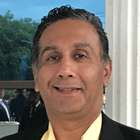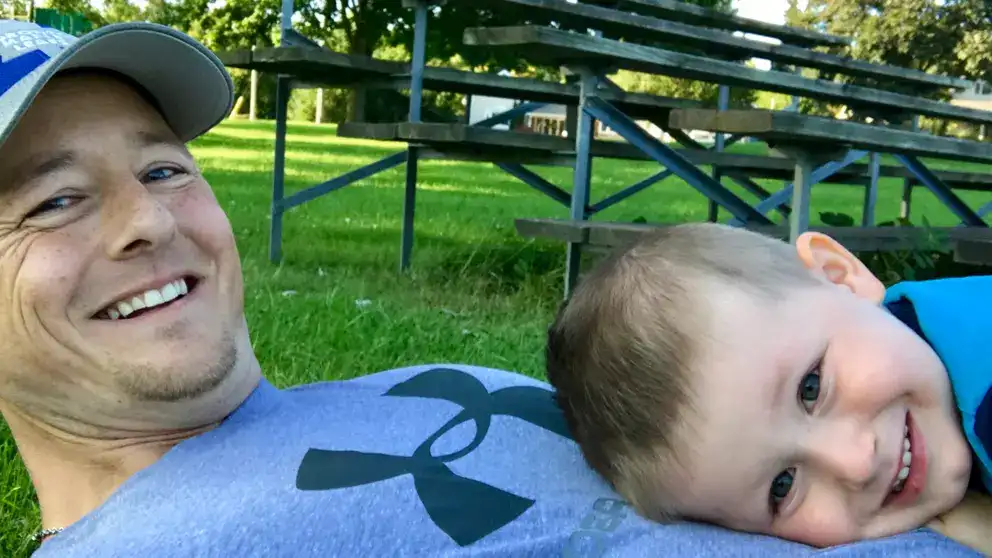Jason and Liz Gaudette will always remember Feb. 1, 2015. After
4 1/2 years of trying for a baby, the couple found out they were expecting. “It was one of the greatest days of my life,” Jason says.
Next day, their joy came crashing down. Jason, then 36, drove home from his job as manager of a fitness club. After he let the dog out and said hello to Liz, she asked, “Why are you slurring your words?”
When she told him to smile, she saw the left side of his face sagging. Jason couldn’t move his left arm. Liz recognized the signs of a stroke and they were soon on their way to the hospital.
Diagnosis and aftermath
Tests quickly revealed that Jason was having a massive stroke. A ruptured blood vessel had caused bleeding into his brain. Doctors immediately prepared him for surgery.
Jason learned later that his stroke was triggered by malformed blood vessels in his brain — a condition he was born with but was unaware of until the stroke.
The surgery likely saved his life, although the stroke left him paralyzed on his left side. Had Liz not identified the signs of stroke and got him to the hospital, Jason most likely would not have survived.
Acting FAST
Stroke is a medical emergency. The faster someone gets medical help, the better their chances of a full recovery. Knowing the signs and calling 9-1-1 can make the difference between life and death, or between full recovery and lasting disability.
FAST is an easy way to help people recognize the signs of a stroke
Facing stroke alone
Jason was lucky that his wife was with him and knew the signs of stroke.
Gurmit Singh Combow had only himself to rely on. The 51-year-old was home alone when his arms and legs started to feel numb.
Thankfully Gurmit had learned the signs of stroke as part of his training as a construction safety officer. When his face started to droop, he knew it could be a stroke. He called 9-1-1.
While family members rushed to his side, doctors diagnosed a stroke in an area of Gurmit’s brain stem that made surgery too risky. In total he spent three months in hospital, in and out of intensive care because of complications.

Everyone should know the signs of stroke.
From being completely bedridden and not able to talk, walk or swallow a single morsel, Gurmit has come a long way. He is back home with his family, doing everything from cooking to cleaning and even driving around the city.
“I am getting better,” he says. “I know the road to full recovery is a long one. But I know I will get there. Everyone should know the signs of stroke."
South Asians at risk
Dr. Preet Chahal, a neurologist who helped care for Gurmit, says it’s especially important for people of South Asian origin to know the signs of stroke.
"South Asians have a two-fold higher risk of diabetes and are three times more likely to have high blood pressure than their Caucasian counterparts," he says. As a result, they face a higher risk of stroke. Dr. Chahal says Gurmit’s timely action likely saved him from more severe complications.
Recovery and beyond
In Jason’s case, doctors were unsure whether he would regain any use of his left arm. But today they are impressed with his recovery, which he attributes to an amazing support system, excellent trainers and therapists as well as his strong faith and determination to be the best father he can be to three-year-old Leighton.
“I wouldn’t take the stroke back,” Jason says, adding that it’s made him a better husband and father. “I learned so much and accomplished so many things in my recovery that I never thought possible.”
Today you would not know Jason had a stroke. He is working as the general manager of a fitness club. He has also begun motivational speaking and is writing a book about his experience.
Sharing their experience
Both Jason and Gurmit are volunteering as spokespeople for Heart & Stroke. They share their stories to spread the important message that everyone should learn the FAST signs.
A stroke can happen to anyone, any time. Knowing the signs of stroke can mean the difference between life and death.
- Get more info on the FAST signs.
- Learn more about stroke.
